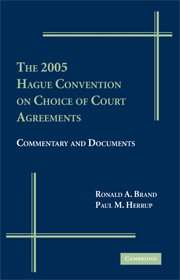Book contents
- Frontmatter
- Contents
- Preface
- PART I A BASIC INTRODUCTION TO THE 2005 HAGUE CHOICE OF COURT CONVENTION
- 1 The Context and History of the Hague Negotiations
- 2 The Convention Structure and Content
- 3 Interpretation and Use of the Convention
- PART II ARTICLE-BY-ARTICLE COMMENTARY ON THE CONVENTION
- PART III CHOICE OF COURT IN THE ABSENCE OF A MULTILATERAL CONVENTION
- PART IV LITIGATION AND ARBITRATION CHOICES AFTER THE HAGUE CONVENTION
- Appendix A Explanatory Report by Trevor Hartley & Masato Dogauchi (including the text of the 2005 Hague Convention on Choice of Court Agreements)
- Appendix B Cited Excerpts from the Nygh-Pocar Report
- Index
3 - Interpretation and Use of the Convention
from PART I - A BASIC INTRODUCTION TO THE 2005 HAGUE CHOICE OF COURT CONVENTION
Published online by Cambridge University Press: 26 October 2009
- Frontmatter
- Contents
- Preface
- PART I A BASIC INTRODUCTION TO THE 2005 HAGUE CHOICE OF COURT CONVENTION
- 1 The Context and History of the Hague Negotiations
- 2 The Convention Structure and Content
- 3 Interpretation and Use of the Convention
- PART II ARTICLE-BY-ARTICLE COMMENTARY ON THE CONVENTION
- PART III CHOICE OF COURT IN THE ABSENCE OF A MULTILATERAL CONVENTION
- PART IV LITIGATION AND ARBITRATION CHOICES AFTER THE HAGUE CONVENTION
- Appendix A Explanatory Report by Trevor Hartley & Masato Dogauchi (including the text of the 2005 Hague Convention on Choice of Court Agreements)
- Appendix B Cited Excerpts from the Nygh-Pocar Report
- Index
Summary
INTERPRETATION OF THE CONVENTION
INTRODUCTION
Any interpretation of a treaty must be rooted solidly in the text. This is especially so with Conventions, like the Hague Convention on Choice of Court Agreements, which arise from a consensus process of negotiation. That process places special emphasis on the words in the provisions of the Convention.
The interpretation of the Convention will be straightforward in many areas – including those areas applicable to most transactions within the scope of the Convention. However, there are issues for which the appropriate understanding of a particular consensus result is not readily apparent from the face of the text. Examples of such understandings include matters for which, after extended discussion and debate, a consensus interpretation of a provision was read into the record of the Diplomatic Conference by the chairman of the drafting committee. Another example of an area where the evidence of consensus may be found outside the face of the text involves questions upon which agreement was reached early in the negotiation of a broader convention, and where that agreement carried over to the final convention.
There are other areas, however, where interpretation will require careful consideration of the weight the text will bear when viewed as a consensus document. Thus, on some matters, the text reflects a consensus that the content of the Convention would be given an autonomous meaning, but for which it was neither possible (nor necessarily desirable) in the Diplomatic Conference to reduce that meaning to specific language.
- Type
- Chapter
- Information
- The 2005 Hague Convention on Choice of Court AgreementsCommentary and Documents, pp. 26 - 36Publisher: Cambridge University PressPrint publication year: 2008

